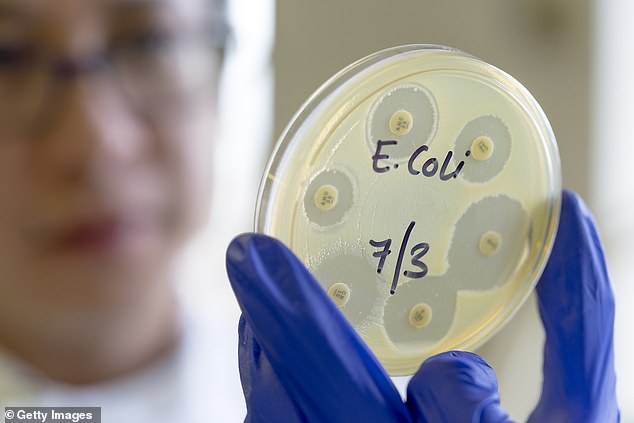Food safety watchdogs have issued a colossal recall of some 30 different types of supermarket sandwiches, wraps and salads over E.coli fears.
A ‘do not eat’ alert notice has been placed on products made by Greencore, and effect foods sold on the shelves of Asda, Amazon, Boots, Morrisons, Sainsbury’s, Co-op and Aldi.
This could amount to many thousands of food items — or more.
Fears centre around Shiga toxin-producing E.coli (STEC) a strain that can cause severe, and even bloody, diarrhoea as well as abdominal pain with cases potentially fatal in some cases.
None of the products have been confirmed to contain STEC but the products have been pulled as precaution.
It comes a week after regulators launched a UK-wide hunt for a mystery food item behind a string of cases up and down the country.
UK health officials have now said 211 people are known to have been infected with the bacteria, up from 113 last week.
At least 67 people have become so ill they have need to be admitted to hospital.
Here, MailOnline reveals the early warning signs of the violent infection, how long they last for, what foods you can get it from, and what you need to do if infected.
UK Health Security Agency (UKHSA) said it believes cases are linked to a ‘nationally distributed food item’ or ‘multiple food items’
What are the symptoms of an E.coli infection?
The outbreak is caused by Shiga toxin-producing E coli 0145 (STEC).
Symptoms of infection vary from mild to bloody diarrhoea, UKHSA says, with around half of people infected experiencing the latter.
Vomiting, fever and stomach cramps are other tell-tale signs of an infection.
However, these symptoms can be caused by a variety of bugs, including norovirus.
In severe cases, the bug can cause haemolytic uremic syndrome (HUS), a life-threatening condition that can lead to kidney failure, which mainly affects children.
A small proportion of adults may develop a similar condition called thrombotic thrombocytopaenic purpura (TTP), which is a rare, life-threatening blood disorder.
Health officials have urged parents to call NHS 111 if they or their kids have bloody diarrhoea.
Children, elderly people and people with compromised immune systems are most at risk of developing a severe illness.
How long does the infection last and what should I do?
Most of those sickened with the bug will get better without NHS care within a week, though sysmptoms can last up to a fortnight.
Infected persons are advised to drink plenty of fluids as symptoms like vomiting and diarrhoea can lead to dehydration.
Health officials say taking antibiotics and antidiarrheal drugs is not generally recommended for STEC.
This is because of the potential of increasing the risk of suffering complications such as HUS, as the drugs impact on the bacteria can cause a build up of toxins.
Anyone experiencing STEC symptoms is recommended to stay home from work or school until 48 hours after you’ve stopped vomiting of having diarrhoea in order to reduce the risk of spreading the infection to others.
People who serve unwrapped food, are a healthcare worker or attend pre-school or nursery are especially at risk of spreading the infection to others.
These people should be screened for STEC prior to returning to work or school according to Government guidance.
Officials have not yet traced the source of the outbreak of Shiga toxin-producing E.coli (STEC), a rare strain of the diarrhoea-causing bug. But they believe it is linked to a ‘nationally distributed food item’ or ‘multiple food items’
What foods can you get it from?
STEC is primarily spread by eating contaminated foods, such as improperly washed or prepared raw vegetables, cheese and undercooked minced meats.
Such foods run the risk of STEC contamination as the bacteria can easily leap from tainted worksurfaces or from infected people preparing food who haven’t washed their hands properly.
For that reason, it’s important to cook minced meat such as burgers properly and thoroughly wash all salad and vegetables to remove any potential traces of animal faces before consumption.
People are also advised to ensure their fridge is below 4C degrees as this can slow bacteria growth.
In a recent previous outbreak of E.coli patients reported eating grated hard cheese before getting ill.
This can happen if the milk gets contaminated with faecal matter and survives or grows during the cheese making processes.
Unpasteurised cheeses, where the milk used to make the dairy product isn’t heated to a bacteria-killing temperature, have a higher at risk of contamination.
STEC can also be spread by touching infected animals or their faeces directly as well as coming into contact with direct with people who are sick, when looking after them for example.
It can also be spread through contaminated water, either via drinking tainted supplies it or accidently ingesting it while swimming,
This risk can be reduced by boiling any drinking water suspected of being unsafe, not swimming in water that could be contaminated by cattle and sheep in nearby fields.
Source: Mail Online
